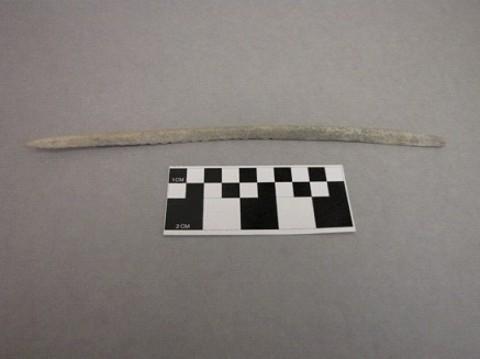While hiking in Denali National Park & Preserve, a sharp-eyed youngster spotted an object that turned out to be a prehistoric hunting artifact of a most unusual sort. This rare find gives scientists an opportunity to learn more about early Athabascan Indian occupancy of interior Alaska.
Last month, children in a hiking group were picking up and playing with objects on a Teklanika River gravel bar. One of the youngsters found a thin, stick-like object about 12 inches long that looked like it might have been shaped by human hands. Suspecting that the object might be an important find, and fearing that the river would wash it away if it remained on the gravel bar, the hikers brought it to the park headquarters.
This unusual object turned out to be an arrow foreshaft carved from an antler. It shows evidence of wear, and one end has been broken off, but it's in surprisingly good shape for its age.
It’s an ingenious piece of technology, too. One end of the stick-like object is cone-shaped so it can be fitted into a socket on the end of the main arrow shaft. (Being only loosely fitted to the main arrow shaft, the foreshaft could separate and remain in an animal’s body, leaving the rest of the arrow available for reuse.) The “tip” or “point” end of the object has been broken off, but it would have been either carved to a sharp point or fitted with a projectile point made of copper, stone, or some other hard material.
Park officials were thrilled to have this artifact. While stone artifacts (lithics) are quite durable and can last for many thousands of years, artifacts made from antler, wood, or other organic materials tend to decompose or wear away fairly quickly, especially when exposed to the elements. They are rarely found centuries later. Not surprisingly, very few non-lithic hunting artifacts have ever been found in the Alaskan interior. This was, indeed, a rare find.
Prior to this electrifying discovery, archeologists studying the park vicinity had only recovered hunting artifacts dating from about 7,000 years ago to about 2,500 years ago. There had been nothing from the early Athabascan occupancy that followed this ancient culture. And now there was.
A sample from this artifact will be submitted for lab analysis. Similar objects found elsewhere have been radio carbon-dated in the range of 100 to 1,100 years old.
Postscript: All artifacts on public lands are protected under federal law, and park visitors who find them should leave them alone. Unusual circumstances prompted visitors to break the rules in this instance, but this is rarely appropriate. As a general rule, visitors can be helpful by taking photographs, recording locations (GPS is best), and reporting artifact discoveries to park officials.




Comments
I used to find lots of antler and bone projectile points and other tools at surface sites along the coast and waterways in northwestern Alaska. The warmer summers in the interior likely contribute to greater rates of decay.